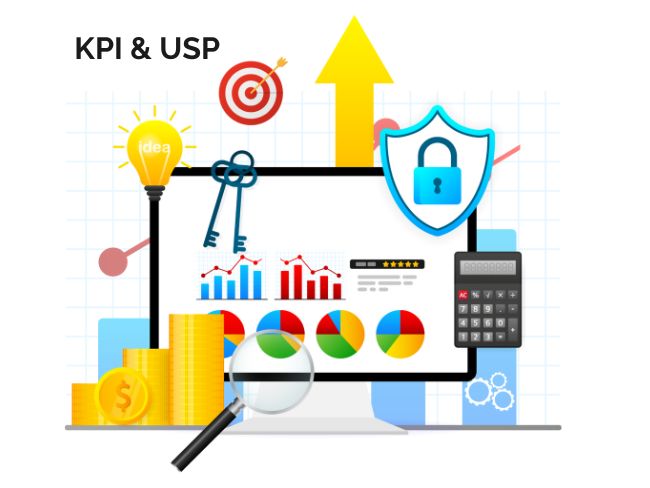Running a small or medium enterprise feels like having to juggle a hundred things at once. How can you ever know if you’re on the right course? That’s where KPI and USP come in—two of the powerful tools that can guide you to success.
Both KPI and USP are crucial for every business. KPIs are measurable goals that describe critical achievements realized toward business growth and efficiency in operations. On the other hand, USPs define exactly what sets a business apart from its competitors—what that business can uniquely offer to its target market.
Together, those indicators not only steer SMEs toward profitability and sustainability, consequently setting them apart in competitive markets but are also indispensable tools in strategic design and market positioning.
Let’s dive in to see why Key Performance Indicator (KPI) and Unique Selling Point (USP) are crucial for your SME.
Table of Contents
1. What is KPI?
2. Why do KPIs matter for Small and Medium-Sized Enterprises (SMEs)?
3. Key KPI for SMEs
4. The Power of USP: Differentiating Your Business
5. Why do USPs Matter for SMEs?
6. Crafting a Strong USP
7. Integrating KPI and USP for Business Growth
8. Conclusion
What is KPI?
KPIs are Key Performance Indicators and are quantifiable figures that demonstrate how well your company is accomplishing certain goals. Consider them the life indicators of your company.
KPIs provide businesses with targets to achieve, and milestones to complete. By consistently monitoring KPIs, organizations can identify their core areas of strength and weakness and take action to stay on track with their business goals.
These KPIs provide actionable insights, thus helping an owner or manager of an SME make effective decisions. By tracking conversion rates or the cost of acquiring a customer, for example, businesses can keep control over the implemented strategies and gain in performance.
Why do KPIs matter for Small and Medium-Sized Enterprises (SMEs) ?
Focus and Clarity
KPIs help SMEs focus on what is important by indicating what warrants extra attention. This clarity will then ensure that all efforts are aligned with the business goals.
Performance Tracking
Regular tracking of KPIs lets one know the performance over time. It identifies trends, gives an early warning for potential problems, and informs decisions that need to be made.
Accountability and Motivation
KPIs make team members feel the urge for accountability. When everyone knows what matters in terms of metrics, they are likely to remain motivated and keep on working toward those targets.
Resource Optimization
SMEs can use them to track areas that are performing above average and those that are not doing so well, hence optimizing resources for maximum return on investment.
Key KPI for SMEs:

Figure: KPIs for SME businesses
Financial KPIs: revenue growth, profit margins, cash flow, ROIs.
Customer KPIs: customer acquisition cost, lifetime values of customers, satisfaction ratings, and retention rates.
Operational KPIs: inventory turns and production efficiency metrics and metrics on quality control.
Marketing KPIs: conversation rates, website traffic, social media engagement, campaign ROIs.
The Power of USP: Differentiating Your Business
Another key component of competitive advantage for any business is a unique selling proposition (USP). A unique selling proposition is exactly what sets your business apart from other businesses. It’s primarily something that makes your product or service special and interesting to your target audience. A good USP has to be clear and specific relative to the needs and wants of the customer.
Why USPs Matter for SMEs?
Value Proposition:
With a clear USP, it becomes easier for more and more customers to choose your product and service over others.
Brand Identity:
Your USP is part of what makes up your brand identity, as it gives voice to values, strengths, and special benefits that give rise to familiar, robust branding.
Customer Loyalty:
By delivering on your USP, you will create a loyal group of customers who value what you uniquely provide. It may result in repeat business and good referrals by word-of-mouth.
High-Impact Marketing:
A clear USP assures high-impact marketing. This conveys a consistent message that the marketing efforts can facilitate or manifest across all channels, ensuring that your audience’s value proposition is rightly communicated and appreciated.
Crafting a Strong USP

Figure: Crafting a strong USP for SME businesses
Identify Your Strengths:
What does your business do exceptionally well? This could be related to product quality, customer service, innovation, or any other area where you excel.
Understand Your Audience:
What are the needs and pain points of your target customers? How can your strengths address these effectively?
Analyze the Competition:
What are your competitors offering, and where do they fall short? Your USP should highlight the unique benefits that set you apart from them.
Be Clear and Specific:
A vague or generic USP won’t resonate with customers. Be clear about what makes you unique and why it matters to your audience.
Integrating KPI and USP for Business Growth
Strategic Alignment:
By aligning your KPI and USP, you will be quantitative about measuring performance against exactly those factors that make your business different. That strategic alignment is going to help keep focus on the main strengths of your business and create continuous value for customers.
Continuous Improvement:
One will have to review and fine-tune KPI and USP from time to time for continuous success. As your business evolves and market conditions change, you will probably be adjusting your KPIs to reflect new priorities and updating your USP to stay relevant and competitive.
Case Study: Successful Integration:
Consider a tiny, independent organic skincare business whose unique selling point is the use of all-natural, sustainably produced components. Customer happiness, recurring business rates, and social media activity about environmentally friendly practices would be some of the key performance indicators. By concentrating on these KPIs, a business ensures that its marketing and operations are consistently in line with and contribute to the realization of its distinctive value proposition, thus securing steadily increasing client loyalty to the brand.
Conclusion:
KPI and USP are crucial instruments for propelling success for SMEs; they are more than simply trendy terms. KPIs offer the information and understanding required to monitor development and make well-informed decisions, while USPs set your company apart in a competitive market and draw in and keep devoted clients. You may lay a solid basis for expansion, creativity, and long-term success by skillfully incorporating these indications into your business plan.
Also, visit the following pages you may like:
The Ultimate Guide to SEO and SEM: Key Differences
How To Choose The Best UI/UX Design Agency In Nepal
Important AI Tools That Every Designer Should Know in 2024
Content Writing Guide: How To Create Engaging Content?
Mobile Number: 977-9808271089 (WhatsApp)
Email Address: info@yetistudio.co
Address: Baraha Marg, Dhumbarahi, Kathmandu, Nepal






Comments are closed